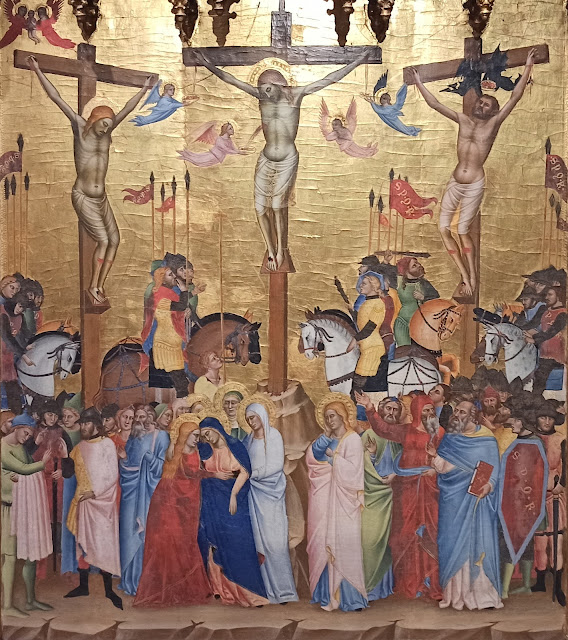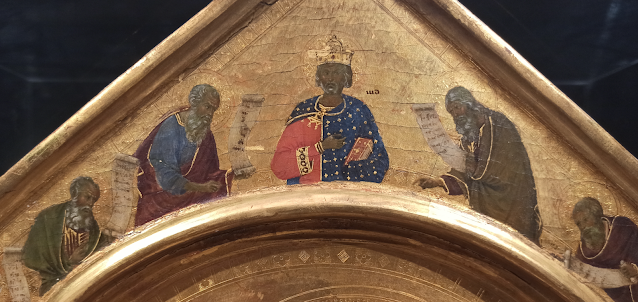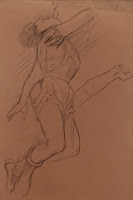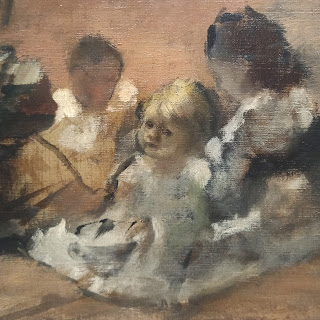I was initially apprehensive about her being a so-called "pioneer". But, she truly is. The mantle is deserved.
She was a leading artist among the avant-garde Bloomsbury Group. They were an eclectic bunch who advanced literary and artistic modernism in Britain at the beginning of the 20th century. Her connections among the Bloomsbury Group are defining: wife of art critic Clive Bell, sister to Virginia Woolf, and the lover to Roger Fry (long-time companion of painter Duncan Grant).
Vanessa Bell is considered pioneering for her contributions to modernist art, the Bloomsbury Group, and the artistic and cultural landscape of her time.
✲✲✲
A Conversation by Vanessa Bell (1913-1918)
A very charming and engaging oil painting. It makes you ask questions.
Vanessa Bell gives us three ladies (everyday female experience) in some purposeful conversation with a flattened perspective. The forms of the ladies is rather abstract in shape and with muted colours.
I do love the arched-and-raised hand — with the other resting nonchalantly. It’s an interesting & intuitive posture which I haven’t seen much of in paintings.
But, ultimately, the viewer is kept at bay.
The arrangement of flowers at the background adds a beautiful contrast to the darker atmosphere of the ladies. Also positioned near the ladies’ mouths which suggests real colour to be gleaned there.
✲✲✲
Design for a folding screen - Adam and Eve by Vanessa Bell (1913-1914)
This is about sexual freedom.
Reminded of the vibrant colours and flattened forms of Henri Matisse.
This depicts Adam and Eve in a verdant Eden — with no serpent in sight. According to the Courtauld, it’s related to the sexual freedom embraced by the Bloomsbury set:
The scene appears to encapsulate the sexual freedom embraced by Bell and other members of the Bloomsbury group. The dynamic nudes appear to be dancing in an enveloping golden light, wholly at ease in their bodies and their environment.
✲✲✲
Arum Lilies and Iris by Vanessa Bell (1919)
Beautiful.
The arrangement of lilies (“still life”) has been matched by such a beautiful ceramic vase which seems to have been painted with even more resplendency. According to the Courtauld:
Giving the vase such attention underscores the importance of every element of the domestic environment in creating the aesthetic of the Bloomsbury interior.
✲✲✲
Still Life at a Window by Vanessa Bell (1922)
Vanessa Bell likes the subdued colours. This was painted in Paris — after WW1.
The way the light floods into the room through the window is beautiful. The white reflecting sheen on the base of the ceramic vessel is subtle but amazing.
Amazing flowers and patterned curtains.
✲✲✲
The Omega Workshop Rugs
At 33 Fitzroy Square in London. Founded by Roger Fry, Vanessa Bell and Duncan Grant in 1913, the Workshop was a design enterprise.
Embracing the vibrancy & simplified forms of the then contemporary movements (e.g., Cubism, Fauvism etc.), many of the designs can be considered British art’s earliest forays into abstraction. (None of the designs were signed. Roger Fry believed they should be anonymous, believing their art should sell entirely on their own merits rather than on the reputation of a particular artist.)
While her designs don't hold much personal interest, I do recognise her broad skills and accomplishment as a designer. She seems to have produced innovative textiles and furniture designs that blended post-impressionist fine art with applied arts.

















































